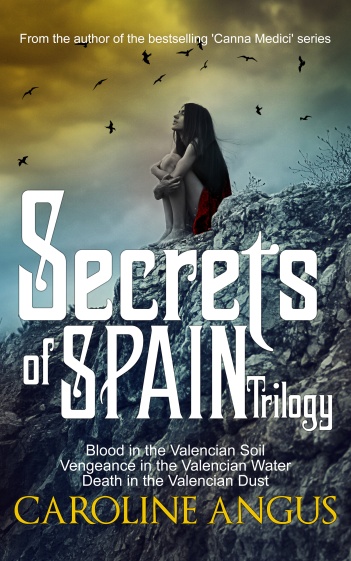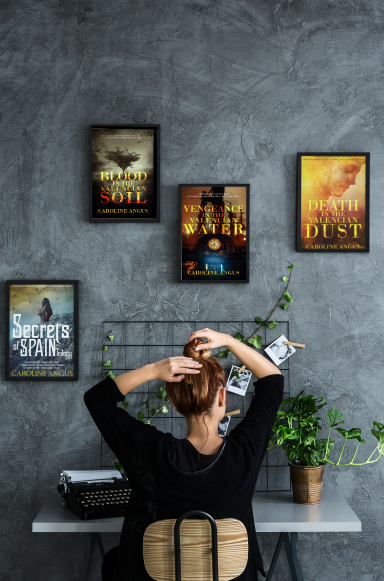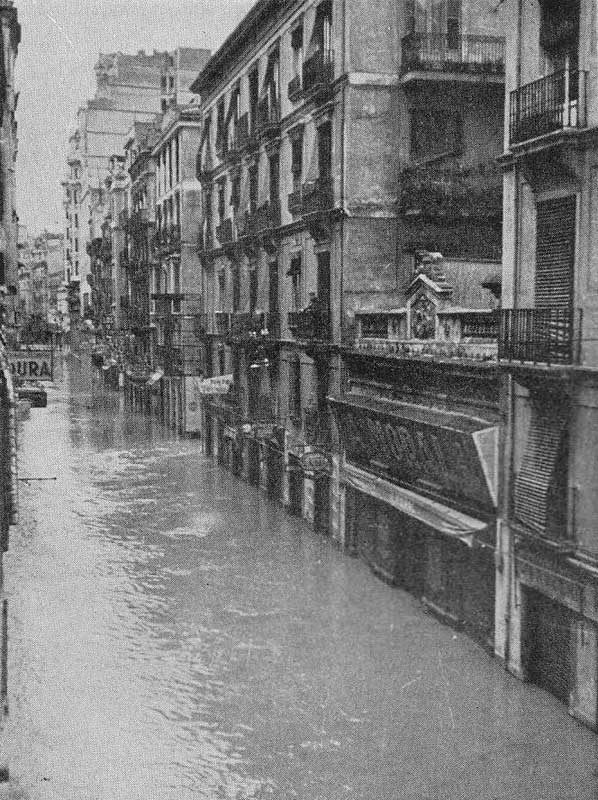
Welcome to Part 3 of this year’s free Kindle book giveaway, with the largest book giveaway I can give you in one download – all three of my Secrets of Spain novels combined into one huge trilogy. From 16 – 20 December 2023, all three books in my Spanish historical series, BLOOD IN THE VALENCIAN SOIL, VENGEANCE IN THE VALENCIAN WATER, and DEATH IN THE VALENCIAN DUST, will all be free to download as a set.
If you have previously downloaded this book, you can get this free new version directly to your device, just go to –
- Amazon Settings – Manage Content and Devices – Books – Update OR
- Amazon Settings – Manage Content and Devices – Preferences – Auto Updates On
Here is the synopsis for the book if you are unfamiliar with my Secrets of Spain fiction, which is a culmination of my Bachelor of History degree I studied in Spain, combined with years of interviews of the survivors of the accounts detailed in the books:

BLOOD IN THE VALENCIAN SOIL
Spain, March 1939 – the Spanish Civil War is coming to an end. Five young Republicans in the small town of Cuenca know they are on the losing side of the war. History only recognises the winners, and the group knows they could die, all destined to become faceless statistics. They concoct a plan to go to Valencia in search of safety, but not all of these young men and women are going to survive…
Seventy years later, bicycle mechanic Luna Montgomery, the granddaughter of a New Zealand nurse who served during the Spanish Civil War, has made Spain her home. A young widow and mother of two little boys, Luna wants to know what became of her Spanish grandfather. He is one of the ‘disappeared’, one of the hundreds of thousands of Spaniards who were murdered and hidden away during and after the war. On a quick trip to Madrid, Luna forms an unlikely friendship with an intelligent and popular bullfighter, Cayetano Beltrán, but as Luna presses on to delve into Spain’s history for answers, Cayetano struggles with truths he wished he had never found out. In an ever-changing society that respects and upholds family ties, betrayal by the people that Luna and Cayetano hold dear will hurt them more than they could have realised. There are old wounds that have yet to heal underneath Spain’s ‘pact of forgetting’.

VENGEANCE IN THE VALENCIAN WATER
Valencia, Spain: October 1957 – After a long hot summer, Guardia Civil officers José Morales Ruiz and Fermín Belasco Ibarra have had enough of their lives. Sick of dealing with lowlifes and those left powerless under Franco’s ruthless dictatorship, the friends devise a complex system of stealing babies, to be sent away to paying families. But as the October rains fall, the dry Valencian streets fill with muddy water, and only greed and self-preservation will survive…
It’s 2010, and Luna Montgomery is busier than ever. With the mystery of her murdered grandfather solved, she reluctantly prepares to be the bride in Spain’s ‘wedding of the year’. But four more bodies lie hidden at Escondrijo, Luna’s farm in the Valencian mountains. Her fiancé, bullfighter Cayetano Beltrán Morales, is not eager to have his name brought up in a post-civil war burial excavation. When Cayetano’s grandfather José, an evil Franco supporter, starts to push his ideals on Luna, her decision to join the Beltrán family comes under scrutiny.
The Tour de France is fast approaching, and Luna’s position as a bike mechanic on Valencia’s new cycling team begins to come under pressure. When an ‘accident’ occurs at Escondrijo, lives hang in the balance as more of Spain’s ghosts come to life and tell the story of a flood in 1957…

DEATH IN THE VALENCIAN DUST
Spain: September 1975 – After 39 years as dictator, Francisco Franco is dying, but his parting words to the nation are leaving a bitter legacy. Jaime Morales, brother-in-law and sword handler for Spain’s greatest bullfighter, Paco Beltrán, finds himself caught up with a young Basque woman named Alazne, who seeks political change with plans of violence. Executions are handed down, and Spain collapses into turmoil in the shadow of their leader’s death and the crowning of a new king. Jaime, Alazne, and the entire Morales family have to face who they are and what they believe…
It’s 2014 and the final season for Spain’s favourite celebrity bullfighter, Cayetano Beltrán Morales. Guided by his father Paco and Uncle Jaime, Cayetano is reluctant to let go of his magnificent career. His wife, Luna Montgomery, has plans as she transitions from mother of the couple’s four children to leader of the Beltrán family while fighting Spain’s ‘pact of forgetting’. Cayetano’s sister, Sofía, has rising political ambitions in Valencia as Spain crowns a new king. The final ghosts of Escondrijo, Luna’s Valencian farm, can finally speak the truth. But the Beltrán Morales family must, at last, recognise their identity, where they sit in Spain’s turbulent present, and their potentially fractured future.
Bodies need to be laid to rest, truths must be acknowledged, and destinies are up in the air as Luna Montgomery finds her long-awaited place in her Spanish family. But death still lurks in the Valencian mountains…
Just go to Amazon US/International, Amazon UK, or your local Amazon page
The sale begins at 00:01 PST on Saturday 16 December and ends at 23:59 on Wednesday 20 December PST. Check your local time zone or see below –
- Auckland, New Zealand: 21:01 Saturday 16 December – 20:59 Wednesday 20 December
- Sydney, Australia: 19:01 Saturday 16 December – 18:59 Wednesday 20 December
- Perth, Australia: 16:01 Saturday 16 December – 15:59 Wednesday 20 December
- Tokyo, Japan: 17:00 Saturday 16 December – 16:59 Wednesday 20 December
- Abu Dhabi, United Arab Emirates: 12:00 Saturday 16 December – 11:59 Wednesday 20 December
- Cape Town, South Africa: 10:01 Saturday 16 December – 09:59 Wednesday 20 December
- Madrid, Spain: 09:01 Saturday 16 December – 08:59 Wednesday 20 December
- London, United Kingdom: Saturday 16 December – 07:59 Wednesday 20 December
- New York / EST: 03:01 Saturday 16 December – 02:59 Wednesday 20 December
- Chicago / CST: 02:01 Saturday 16 December – 01:59 Wednesday 20 December
And stay tuned for Part 4 of my Christmas giveaways on Thursday 21 December!

























































